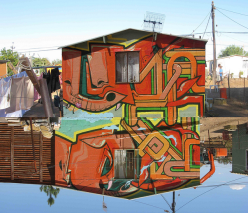Love it. Hate it. Face it. Graffiti plays its part in making any city wonderful. This issue, we focus on Cape Town.
 Graffiti artist Freddy Sam is like a model student among bad boys. In Woodstock, the arty precinct of Cape Town where he lives, he paints portraits on abandoned buildings. In the nearby Percy Bartley orphanage, he puts up murals and conducts weekly art workshops. And in his free time, he invites graffiti artists from across the world to come to Cape Town and leave their (paint-spattered) mark behind.
Graffiti artist Freddy Sam is like a model student among bad boys. In Woodstock, the arty precinct of Cape Town where he lives, he paints portraits on abandoned buildings. In the nearby Percy Bartley orphanage, he puts up murals and conducts weekly art workshops. And in his free time, he invites graffiti artists from across the world to come to Cape Town and leave their (paint-spattered) mark behind.
Now if only everyone loved their home this much.
Graffiti is often considered a form of vandalism. But with every piece of work I’ve seen and every artist I’ve met, it feels more like a homage to the city. A gesture of how much the artists love where they live – akin to a boy giving a rose to his girl. And most of the artists of Cape Town have reserved their grandest gestures for Woodstock. As a former industrial suburb, Woodstock’s unused warehouses became the space for galleries and studios to come up. And come up they did. Its many cottages and old factories are now covered with the best street art you’ll see in the city. And it also houses A Word of Art – an exhibition and residency space for international artists that’s hosted MYMO from Berlin, Boa Mistura from Madrid and David Shillinglaw from London. They’ve all left Woodstock far prettier than before they arrived.
But it’s the local artists of Cape Town who are truly striving to engage with the community – be it with gangsters or old aunties. They keep coming up with projects that take on a life of their own. Like artist Falko’s ‘Once upon a town’ and ‘Darling made me do it’ that were meant to create public interest in towns about an hour away from Cape Town. He created split-pieces, that is, one image divided into sections and painted on different walls, by collaborating with other artists. Today, the three towns – Mamre, Pella and Darling – have become tourist places in their own right. The ‘Freedom Charter’ project by Faith47 is another example where she’d taken quotes from the original document written by the African National Congress and put them all over Cape Town, sometimes with archangels falling over them. It’s this unique kind of creative activism that’s helped the city become the World Design Capital 2014.
For nearly half a century, South Africa was divided in two colours. To walk around Cape Town and seeing its multi-hued walls, you’d think it’s making up for all the lost time.
Published in TimeOut Explorer Mar-Apr 2013.
